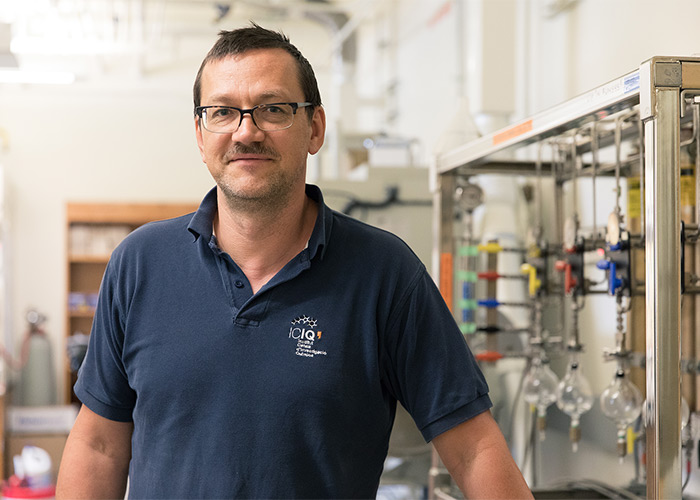Improved Methods for Carbon-Hydrogen Bond Reactions
“At a university, it’s important to do fundamental research,” said Olafs Daugulis, Robert A. Welch Chair of Chemistry at the University of Houston. “Having graduate students work on fundamental problems, where there are no clear answers, is an important part of teaching them how answer hard problems.”
Breaking the Carbon-Hydrogen Bond
Daugulis’ research has received a 4-year, $1.2 million grant from the National Institutes of Health’s National Institute of General Medical Sciences, which marks the third round of funding for this project. The focus is on developing improved reactions for breaking the carbon-hydrogen bond, one of the most common in nature, in order to replace the hydrogen with a functional chemical group.
 Olafs Daugulis, Robert A. Welch Chair of Chemistry, received a 4-year $1.2 million
NIH grant to support his research on carbon-hydrogen bond functionalization reactions.“The carbon-hydrogen bond is extremely hard to break selectively,” said Daugulis,
who has been a faculty member in the College of Natural Sciences and Mathematics since
2003.
Olafs Daugulis, Robert A. Welch Chair of Chemistry, received a 4-year $1.2 million
NIH grant to support his research on carbon-hydrogen bond functionalization reactions.“The carbon-hydrogen bond is extremely hard to break selectively,” said Daugulis,
who has been a faculty member in the College of Natural Sciences and Mathematics since
2003.
This reaction, known as carbon-hydrogen bond functionalization, is a fundamental problem with broad potential applications.
Given that hydrocarbons are in plentiful supply, the ability to break this bond, replacing the hydrogen with a functional group, enables researchers and industries to use these hydrocarbons as the building blocks for a broad spectrum of compounds, some of which may have applications in medicine or industry.
Improved Reaction Methods to Decrease Cost, Waste
For Daugulis, the goal is to develop improved reaction methods, generating a diversity of compounds.
In a carbon-hydrogen bond functionalization reaction, the carbon-hydrogen bond gets cleaved by a metal catalyst, and ultimately the hydrogen atom gets replaced by a functional group.
Historically, palladium has been the most common metal used for these reactions. Given that palladium is a rare and expensive metal, the challenge is to find substitutes that are cheaper, and can be done in fewer steps.
Cutting down on the number of steps in a reaction, or cutting down on the amount of reactants needed, when considered on an industrial scale, leads to decreased waste, and also decreased costs. This is green chemistry, and economical chemistry, all in one.
Developing Economical Alternatives to Palladium
For this round of funding, Daugulis’ research group will be developing reactions using
elements such as cobalt and copper, which are cheaper and more plentiful alternatives
to palladium. The drawback to
using these metals is that they offer less control, a limitation his research group
is trying to address.
Daugulis’ team will also work on systematizing these reactions, so that instead of
working out the properties of one reaction at a time, they can predict how these reactions
will work on a general level.
Currently, Daugulis’ methods are being used in the pharmaceutical industry, to generate large libraries of compounds that can be screened for potential use.
Daugulis’ work provides knowledge, methods and materials for other researchers to work on solutions, while training the next generation of scientists to answer hard problems.
- Rachel Fairbank, College of Natural Sciences and Mathematics